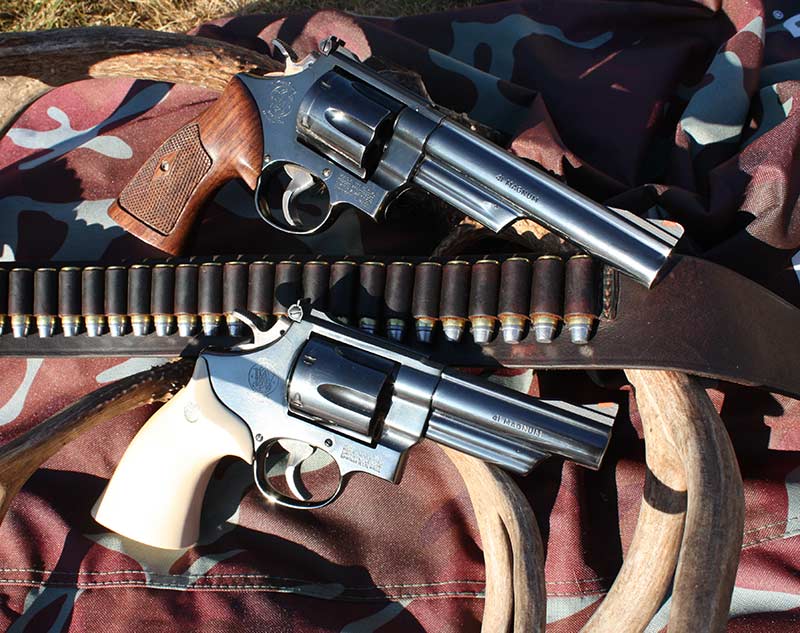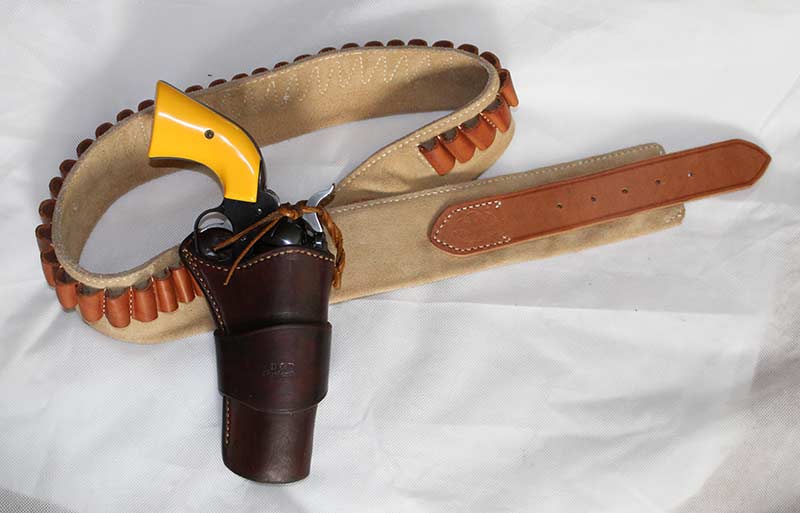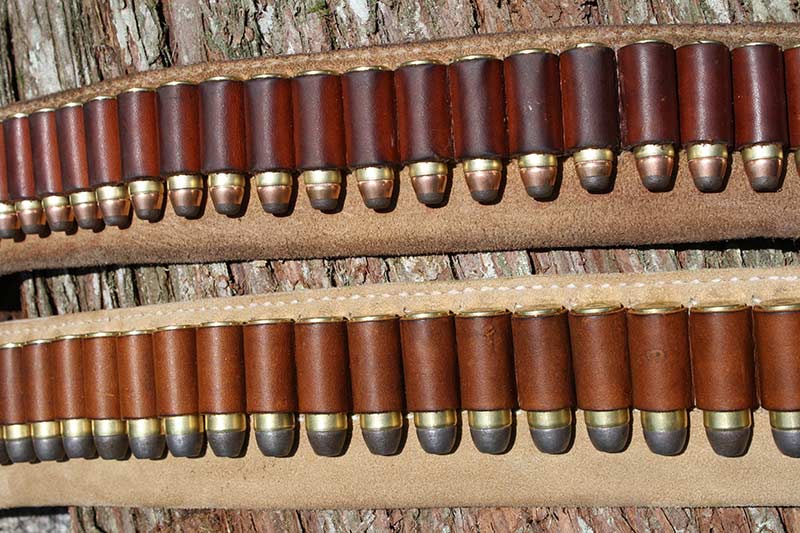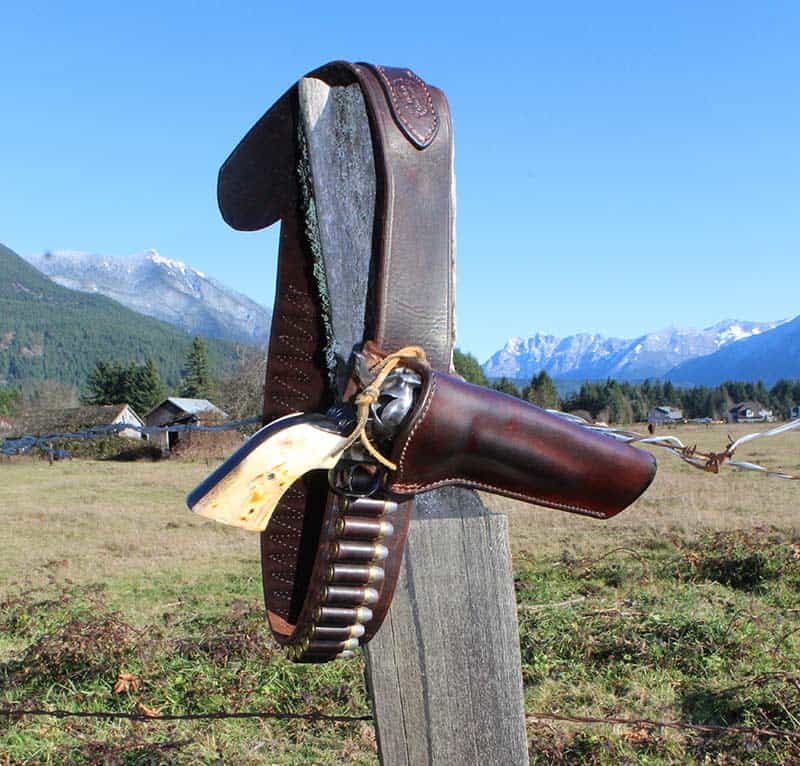I worked out a formula for measuring the actual length of a loop, by wrapping the thin leather loop material around a cartridge against a flat surface. For example, for the .38 Special/.357 Magnum, one marks off half-inch spaces between lines of stitching on the belt. The actual finished loop enclosing the cartridge measures one inch from stitch line to stitch line, to wrap around the cartridge, and my loops are an inch wide top-to-bottom to keep cartridges secure.
For the .32 H&R Magnum/.327 Federal, the loop distance is 7/8-inch with stitching at 15/32-inch. On my .41 Magnum belts, each loop requires 1 1/8-inch stitched every 9/16-inch, while the .44 Special/.44 Magnum loops require just a bit more leather (1 3/16-inch) also stitched at 9/16-inch intervals. For the .45 Colt, I also use 1 3/16-inches of leather, stitched down every 5/8-inch. The loops may be a little tight, but the upside of that is I’m not going to worry about losing cartridges.
Duke Wayne’s usual screen gunbelt in his later films (I think, beginning with “Hondo”) was a rough-out, and whoever designed it was a genius. I built one as an experiment and it became immediately obvious this type of cartridge belt was a smart idea. Unlike lined gunbelts typically seen in films, Wayne’s belt didn’t shift around, and neither did my rendition. It stayed in place; an important consideration for a film character who may need to reach for his gun before the end of the third reel.
The Magic of a Cartridge Belt
Since my youth watching TV westerns and films featuring Jimmy Stewart, John Wayne, Randolph Scott, Joel McCrea or Audie Murphy, I’ve been fascinated with cartridge belts, especially the ones that were fully loaded with nary an empty loop.
Remember how the hero could do all kinds of shooting and never seemed to empty his gunbelt? Richard Boone’s “Paladin” was like that; he might plug a bad guy or two during his 30-minute adventures in “Have Gun-Will Travel,” but he seemed to violate one of the most common-sense rules of the western hero-for-hire: Never holster an empty sixgun, which would necessitate pulling cartridges from his gunbelt.
In the films, Wayne and Scott appeared on the big screen with empty loops in their gunbelts, and Stewart can be seen in a couple of Anthony Mann oaters actually reloading his sixgun from his cartridge belt! That would be blasphemy in a “B” western, but in the big budget films, this little detail told the audience these men used their guns and didn’t bother replacing their spent cartridges immediately.
In Tacoma, Washington where I grew up, there was an annual Daffodil Festival with a Saturday parade featuring the mounted sheriff’s posse and these guys always saddled up wearing fancy revolvers with fully-loaded cartridge belts. Some were handsomely tooled while others looked like “working” gunbelts that had a life outside of a parade, yet they were obviously well cared-for. They weren’t fancy, just functional, and they looked good!
I had a couple of store-bought cartridge belts once and somehow they didn’t really meet my “standard” of what a gunbelt should look like. One had 20 stitched loops; another had loops that were pushed through slots and tightened to fit around cartridges, and the loops never seemed to stay tight and hold my spare rounds secure.
After buying my first .41 Magnum Ruger Blackhawk, I asked the old George Lawrence Company in Portland, Oregon to build a gunbelt with 30 loops and a Keith holster for a 6 ½-inch Blackhawk, which they did at a reasonable price, and the folks I dealt with were some of the nicest people I’d ever encountered. They knew exactly what I was up to and were very accommodating. My gear arrived a couple of weeks later, extremely well-oiled and ready for the field. I still have the holster but my waist has expanded beyond the reach of that beautiful “plain Jane” belt with a tapered billet. I believe I gave it to a skinny friend.
Many years ago I read in some magazine biography of the late Gen. George S. Patton where he had observed the semi-auto pistol was a two-piece handgun, while the revolver only needed loose ammunition to remain functional. Lose a pistol magazine and you’re in trouble without a spare, but a belt full of spare ammunition keeps the wheelgun busy. Maybe that’s why Patton usually wore his .45 Colt single action during WWII in the field and sometimes riding on the other side was a .357 Magnum Smith & Wesson.
That little bit of savvy from the late general was stored safely away in the back of my mind. It has helped me appreciate revolvers and gun belts all the more.
Eventually, I started building my own belts, with 30 or 36 loops. It always seemed a good idea to load up and throw a full belt behind the seat of my truck when preparing for a hunting trip. With a good sidearm, one always has a gun at hand, and as my late pal Vence Malernee once observed, “A gun is a great deterrent to violence.”
I learned a couple of things over the years of working with leather cartridge belts. If you plan to leave cartridges in the belt, nickel-plated cartridge cases don’t get goobered up and turn green like plain brass when kept in loops for a long time. During the off-season, I remove cartridges from my belts, allowing the leather to rest.
Mine was built from thick suede, doubled-up with a bit of reinforcing inside along the area supporting the cartridge loops and where the holster would ride.
Now I have rough-out belts as well as traditional smooth surface belts for my .41- and .45-caliber sixguns. It’s possible to protect these from the weather by spraying them with silicone, but I annually treat the leather cartridge loops with Neatsfoot oil inside and out to prevent them from drying and cracking. With my smooth leather cartridge belts, I’ll treat them with warm oil and maybe a bit of saddle soap applied by hand at least once a year.
Cartridge belts are important pieces of equipment, and they can look as fancy or plain as one desires. They look best when fully loaded, and if they’re properly cared for, should last a lifetime.







